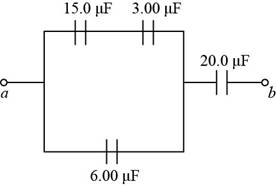
Concept explainers
Four capacitors are connected as shown in Figure P25.11. (a) Find the equivalent capacitance between points a and b. (b) Calculate the charge on each capacitor, taking ΔVab = 15.0 V.
Figure P25.11

(a)
Answer to Problem 11P
Explanation of Solution
Given information:
The four capacitors are connected in figure given below:

Figure (1)
Explanation:
The capacitors
Formula to calculate the equivalent capacitance when they are connected in series.
Here,
Substitute
The capacitors
Formula to calculate the equivalent capacitance when they are connected in parallel.
Here,
Substitute
The capacitors
Formula to calculate the equivalent capacitance when they are connected in series.
Here,
Substitute
Thus, the equivalent capacitance between
Conclusion:
Therefore, the equivalent capacitance between
(b)
Answer to Problem 11P
Explanation of Solution
Given information:
The voltage across

Explanation:
Formula to calculate the total charge in the circuit.
Here,
Substitute
Thus, the total charge in the circuit and the charge through
Formula to calculate the potential drop across
Substitute
Thus, the potential drop across
Formula to calculate the potential drop across
Substitute
Thus, the potential drop across
Formula to calculate the charge across
Substitute
Thus, the charge across
The charge across capacitors
Calculate the charge for the capacitor
Substitute
Thus, the charge across capacitors
Conclusion:
Therefore, the charge across capacitors
Want to see more full solutions like this?
Chapter 25 Solutions
Physics for Scientists and Engineers
- Lab 8 Part 3 PHET Wave Interface simulation. I am having trouble with this part of the lab.arrow_forwardMick and Rick are twins born on Earth in the year 2175. Rick grows up to be an Earth-bound robotics technician while Mick becomes an intergalactic astronaut. Mick leaves the Earth on his first space mission in the year 2200 and travels, according to his clock, for 10 years at a speed of 0.75c. Unfortunately, at this point in his journey, the structure of his ship undergoes mechanical breakdown and the ship explodes. How old is Rick when his brother dies?arrow_forwardHi, I have canceled, why did you charge me again?arrow_forward
 Physics for Scientists and Engineers: Foundations...PhysicsISBN:9781133939146Author:Katz, Debora M.Publisher:Cengage Learning
Physics for Scientists and Engineers: Foundations...PhysicsISBN:9781133939146Author:Katz, Debora M.Publisher:Cengage Learning Physics for Scientists and EngineersPhysicsISBN:9781337553278Author:Raymond A. Serway, John W. JewettPublisher:Cengage Learning
Physics for Scientists and EngineersPhysicsISBN:9781337553278Author:Raymond A. Serway, John W. JewettPublisher:Cengage Learning Physics for Scientists and Engineers with Modern ...PhysicsISBN:9781337553292Author:Raymond A. Serway, John W. JewettPublisher:Cengage Learning
Physics for Scientists and Engineers with Modern ...PhysicsISBN:9781337553292Author:Raymond A. Serway, John W. JewettPublisher:Cengage Learning Principles of Physics: A Calculus-Based TextPhysicsISBN:9781133104261Author:Raymond A. Serway, John W. JewettPublisher:Cengage Learning
Principles of Physics: A Calculus-Based TextPhysicsISBN:9781133104261Author:Raymond A. Serway, John W. JewettPublisher:Cengage Learning Physics for Scientists and Engineers, Technology ...PhysicsISBN:9781305116399Author:Raymond A. Serway, John W. JewettPublisher:Cengage Learning
Physics for Scientists and Engineers, Technology ...PhysicsISBN:9781305116399Author:Raymond A. Serway, John W. JewettPublisher:Cengage Learning College PhysicsPhysicsISBN:9781305952300Author:Raymond A. Serway, Chris VuillePublisher:Cengage Learning
College PhysicsPhysicsISBN:9781305952300Author:Raymond A. Serway, Chris VuillePublisher:Cengage Learning





